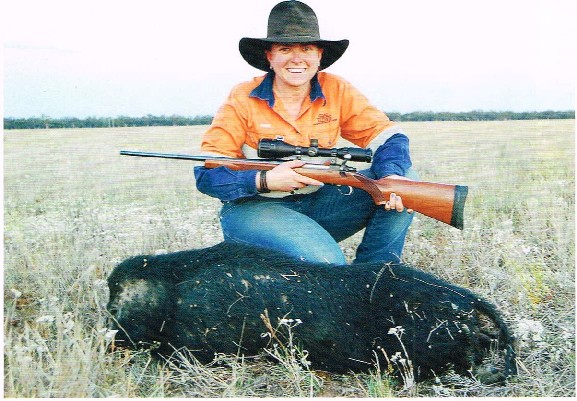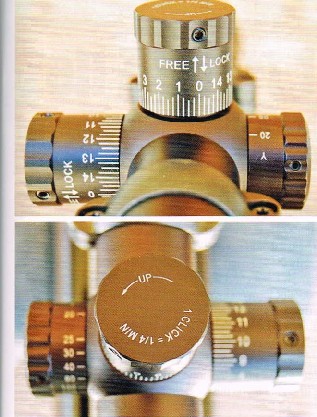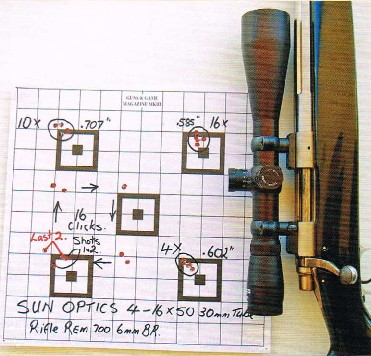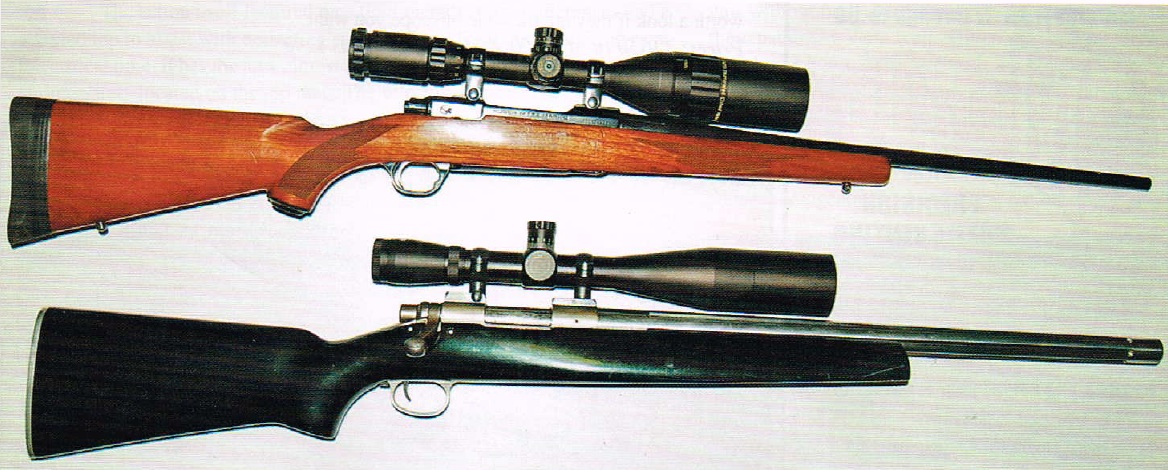
Sun Optics 3-9x50 Mil Dot & 4-16x50 Saddle Fcus Mil Dot

Sun Optics sighting equipment is relatively new to me so it is with interest that I tackle these two new scopes. They are both fairly formidable in stature, particularly with their sun shades attached. They both measure 420mm (16.S") long with shades attached, the sun shades are both 75mm (2.9") long. The 3-9x50 has a 1" main tube with 130mm of usable tube, with the turret just forward of the centre. The 4-16x50 has a 30mm tube, with l34mm of usable tube with the turret just slightly to the rear of centre. These dimensions should allow easy mounting on most firearms of the modern era. Both scopes are made in China. At least they are not afraid to say so, as a lot of new equipment manufactures go to great lengths to hide the country of origin.
Both scopes have Target/Tactical adjustment turrets which are exposed with no caps. The 3-9 has a very tactile locking ring/nut under each turret which is screwed anti clockwise to lock each adjustment after you have your rifle shooting where you want it. These turrets are also zeroable with the use of an allen key provided, which is used to loosen the knob on each cap to allow it to be zeroed. This system seems to be pretty foolproof.
The 4-16 has exposed Tactical style turrets also, but they are of a different design. These turrets are pulled up to adjust the point of impact, and when they are put down they are locked. They are clearly marked on the turrets so you know how to operate them. They do function well, as I used this scope on the Lithgow Crossover. Both scopes have "Mil Dot" style reticles.
Because the scopes are so different I will concentrate on one at a time.
The 3-9x50 AO with an illuminated reticle - this scope's reticle appears to be glued to a lens, as there is a faint shadow around the centre Mil Dot portion of the reticle. The whole of the Mil Dot section of the reticle is illuminated, and the colour can be changed from red to green to blue. There are three intensities on each colour with an off in between each colour. The illumination seems to give a "ghosting" around the reticle, and I found it a bit disconcerting. At night even on the lowest intensity I found it was like trying to see what was behind an oncoming car with its headlights on high beam. This may sound as if I am being critical, but this is what I experienced. This scope proved to be a little harder to mount than I first thought, as the front lens is 50mm but the focusing adjustment ring is quite a bit larger at 62mm. There is only just enough tube length as the ocular housing is quite long at 105mm plus or minus a bit for focus, from the usable tube to the back of the eyepiece, and so it can only just go forward far enough to allow correct eye relief. The 4-16 by comparison is only 82mm long from usable tube to the back of the eyepiece. If the rifle had stiffer recoil than the 6mm Remington I put this scope on for the test, I would be hesitant to shoot it as it would be too close to your eye. This wouldn't be a problem if you chose a Picatinny rail, but the Ruger 77 has no forward and aft mount ring adjustment.


Minnie and I were coming back from the neighbours just on dark, and a lone boar that had had a run in with a dog in his past was standing out in the paddock about 100 yards from the track. It gave Minnie a good Texas heart shot opportunity as he was in a vulnerable position and he tried to head for cover. Minnie had him in her sights, and as the 6mm Remington / Sun Optics combination was there for testing, she hit him with a 95gr Nosier Ballistic Tip which did about as good a job as could be asked for. There was evidence that the bullet had penetrated all the way into his chest. As you can see he looks a bit odd with only one ear!
The 4-16x50 saddle focus is more a varmint / target style scope with a mil dot reticle and is fairly weighty at 800 grams ( 11lb 12oz). The optics are good up to about 10 power, and from then on the optics get very critical especially on 16 power. The saddle focus is most necessary for any sort of clarity. The field of view is very restricted on the high powers and is only 1890 mm (6'2") at 100 yards on 16 power. On 4 or 5 power it becomes a reasonable hunting scope. The turrets are 29mm above the main tube and this is what could detract from its hunting usefulness a bit as they become a snag point on a hunti ng rifle while you are carrying it. This is not a criticism, but a fact of its stature, and I say it so you might better match the scope to the required task.
The 4-16x50 was mounted on the black / green 6mm BR and I conducted the normal Guns and Game test which turned out to be a waiting game as we had been having some extraordinarily windy weather. I could wait no longer so at about 5:30 one afternoon the rifle was sighted in and away I went with the test. With the scope set on 16 power the first thing to do was get parallax set to zero. First set the saddle focus on 100 and then set the rifle in the sand bags so the reticle is on the target. Now check the movement of the reticle against the target while looking through the scope without touching the rifle or bench. Then adjusting the saddle focus a little at a time until the reticle stands perfectly still on the target when you move your eye. This is zero parallax. There was a stiff south westerly breeze blowing, but the bank of timber on that side of the range protects it a fair bit. Shooting conditions were still not perfect. I filled a 5 shot group on 16 power for what turned out to be the best group of the 3 groups I would fire at 0.585". Then a 5 shot group on 10 power for 0.707" and a group on 4 power for 0.602". Given the conditions where there was little wind effect on the bullet as the wind was blowing almost down the range from behind me, it was certainly affecting how still I could hold.
There is a very slight shift in point of impact on each of the three powers, but I would have confidence that even a crow at 200 metres would be in trouble. Just out of interest the 16 power group was shots 3 to 7 from mounting the scope, the first 2 shots were fired at 50 yards.

The round the target test I decided to use 16 clicks as that should give 4" as each click is meant to give 1/4 per click. The result is 3.1" vertical and 3.3" horizontal. This discrepancy is common, and I would have to say after all the scopes I have tested, there are very few that are exactly the same left to right and up and down. I actually mark each turret before I move them so I can check to make sure I haven't made a mistake. While that is not the stated amount to my way of thinking, the fact that the clicks are smaller than, stated on the turret is a good thing. The clicks were not perfectly aligned with the graduations on the turrets. The horizontal turret is closer than the vertical one. This may be a bit of an issue if you were trying to dial in a given drop or wind. But you have the "Mil Dots" for that already in the scope's reticle. While I wasn't able to shoot any super groups, the consistent results given the prevailing conditions were to the point that I would have confidence in saying if you miss a varmint inside 250 metres, your rest was probably to blame.
In conclusion both the Sun Optic copes performed well and did nothing wrong while I was testing them. I am not a fan of exposed turrets even when they have locking nuts or blocks, but they are what they are and they didn't give trouble and I had the 3-9x50 in the truck for about a week and every time I got it out l was able to hit what I aimed at, so it works. Given the reasonable prices, these scopes are well worth a look if they are the style of scope you want.
Prices: 3-9x50 IR AO $200, 4-16x50 Side Focus $290